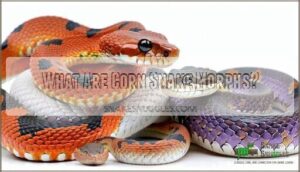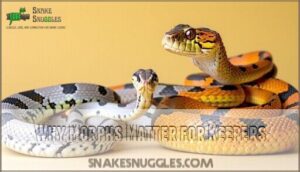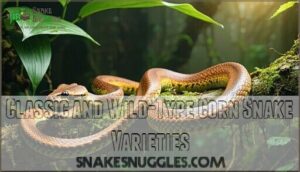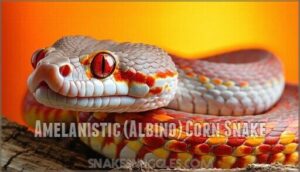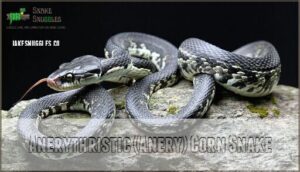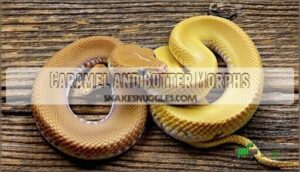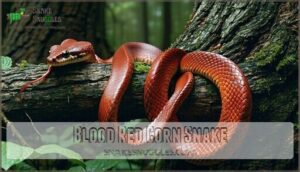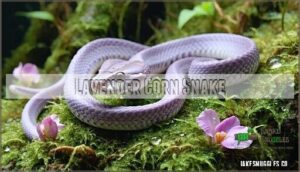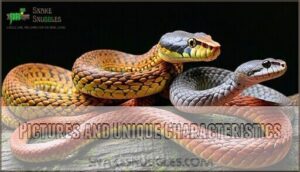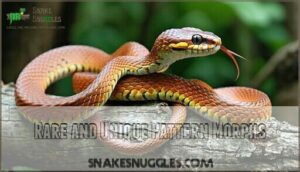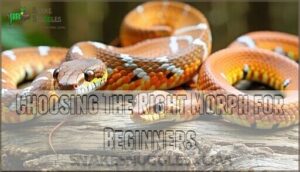This site is supported by our readers. We may earn a commission, at no cost to you, if you purchase through links.
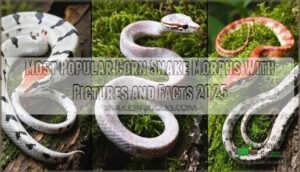 The most popular corn snake morphs with pictures and facts showcase remarkable genetic diversity that transforms these beloved reptiles from their wild orange-and-red appearance into stunning variations. Amelanistic (albino) morphs strip away dark pigments to reveal bright reds and whites, while anerythristic varieties eliminate reds for striking black-and-gray patterns. Classic morphs like Okeetee display bold red saddles with black borders, and rare specimens like scaleless or palmetto morphs can command thousands of dollars.
The most popular corn snake morphs with pictures and facts showcase remarkable genetic diversity that transforms these beloved reptiles from their wild orange-and-red appearance into stunning variations. Amelanistic (albino) morphs strip away dark pigments to reveal bright reds and whites, while anerythristic varieties eliminate reds for striking black-and-gray patterns. Classic morphs like Okeetee display bold red saddles with black borders, and rare specimens like scaleless or palmetto morphs can command thousands of dollars.
Breeders create these wild variations by working with recessive genes over multiple generations. You’ll find everything from affordable $30 normal corn snakes to jaw-dropping collector morphs that sell for $1,500 or more.
Knowing how these genetics work makes choosing your first (or next) snake way easier.
Table Of Contents
- Key Takeaways
- Most Popular Corn Snake Morphs With Pictures
- Classic and Wild-Type Corn Snake Varieties
- Striking Color Morphs and Their Features
- Rare and Unique Pattern Morphs
- Choosing The Right Morph for Beginners
- Frequently Asked Questions (FAQs)
- How much does a palmetto corn snake typically cost?
- What is the average price range for a blizzard corn snake?
- Can you provide a picture of a striped corn snake?
- How often do corn snake morphs shed?
- Can different morphs breed together successfully?
- Do morphs affect corn snake lifespan?
- Which morphs are hardest to find?
- Are morph genetics predictable in offspring?
- Conclusion
Key Takeaways
- Normal corn snakes cost $30–$100 and make perfect starter pets with their forgiving nature and classic orange-red patterns that showcase natural beauty without genetic complications.
- Amelanistic morphs strip away dark pigments to create bright reds and whites with pink eyes, while anerythristic varieties eliminate reds for striking black-and-gray patterns.
- Rare morphs like palmetto and scaleless can cost $600–$1,500+ due to their unique genetics—palmetto snakes have white bodies with random colored speckles, while scaleless varieties lack traditional scales entirely.
- All corn snake morphs share the same calm temperament and basic care needs—40-gallon tanks, feeding every 7–10 days, and handling 2–3 times weekly regardless of their color or pattern genetics.
Most Popular Corn Snake Morphs With Pictures
Think of corn snake morphs as nature’s art project gone wild. These genetic twists turn the classic orange-and-red wild snake into everything from snow-white beauties to deep charcoal stunners.
These morphs range from common varieties like amelanistic (albino) to rare finds like palmetto, giving you countless options whether you’re a beginner or experienced keeper.
What Are Corn Snake Morphs?
Think of corn snake morphs as nature’s paint palette gone wild – these genetic variations transform ordinary snakes into living works of art. A morph is simply a corn snake with an altered appearance due to genetic mutations or selective breeding.
Corn snake morphs transform ordinary snakes into living works of art through genetic variations and selective breeding
These snake color mutations affect everything from bright reds to deep purples. Some corn snake genetics create pattern changes, while others modify colors entirely.
Hybrid variations even combine different snake species for unique trait characteristics.
How Morphs Are Created (Genetics & Breeding)
Corn snake genetics fascinate breeders because small mutations create dramatically different looks. Most of those eye-catching morphs you see? They come from recessive genes – meaning you need two copies to actually see the trait show up.
Breeders use this predictable inheritance to their advantage. They’ll work with specific genetic lines over multiple generations, carefully controlling which snakes produce offspring to lock in those desired traits.
Here’s how corn snake breeding creates new morphs:
- Single gene mutations – Like amelanistic (albino) or anerythristic traits that remove specific pigments
- Compound morphs – Combining multiple recessive genes creates complex patterns like Snow morphs
- Hybridization techniques – Crossing with related species introduces new genetic material
- Genome sequencing advances – Modern DNA mapping identifies exact mutation locations for precise breeding
Over 90% of corn snake morphs result from recessive inheritance. Understanding the variations in corn snake morphs is important for breeders. Breeders use these predictable patterns to produce desired offspring consistently.
Why Morphs Matter for Keepers
Choosing a morph goes way beyond pretty colors—you want something that actually fits your experience, wallet, and where you’re headed as a snake keeper.
Getting familiar with different morphs teaches you about genetics, responsible breeding practices, and how your choices affect wild populations.
Corn snake morphs run the gamut from affordable starter options to investment-level rarities.
Your snake’s morph isn’t just about looks—it’s about finding the perfect match for your experience level, budget, and long-term goals as a keeper. Morph identification helps you understand genetic diversity and breeding ethics while considering conservation impact. Popular corn snake morphs vary widely in price and care requirements.
| Morph Type | Best For |
|---|---|
| Normal/Wild-Type | Beginners, budget-conscious keepers |
| Amelanistic | First-time morph buyers |
| Okeetee | Intermediate keepers wanting classic beauty |
| Palmetto | Seasoned collectors with higher budgets |
| Lavender | Experienced breeders seeking rare genetics |
Snake care and reptile care selection become easier when you match morphs to your skill level and commitment to proper husbandry.
Classic and Wild-Type Corn Snake Varieties
Before exploring the flashy designer morphs, let’s start with the classics that built corn snake breeding.
These wild-type and heritage varieties showcase the natural beauty that made corn snakes popular in the first place.
Normal (Wild-Type) Corn Snake
Before you get started with designer morphs, it’s worth understanding the baseline that started it all. The normal corn snake represents wild-type genetics at their finest. These snakes display the natural habitat coloration that’s kept them thriving for centuries.
Why Normal Corn Snakes Make Perfect Starters:
- Beginner suitability is unparalleled – they’re incredibly forgiving
- Pattern variations still offer plenty of visual interest
- Conservation status remains stable in the wild
- Corn snake characteristics shine through without genetic complications
- Snake patterns show the classic orange-red blotches that define the species
Normal morphs prove that wildtype doesn’t mean boring.
Okeetee Corn Snake
If you’re looking for a corn snake that screams "classic beauty," the Okeetee might just be your perfect match. These snake morphs showcase deep red saddles with bold black borders against a bright orange backdrop.
Okeetee genetics create striking pattern variations that make breeding Okeetees rewarding for experienced keepers.
With proper Okeetee care, these corn snake varieties offer the same 15-20 year Okeetee lifespan as other corn snake color morphs.
Miami Phase Corn Snake
Picture a corn snake that looks like it stepped out of the Florida Everglades with a sleek, silver-gray coat and bold orange accents—that’s the Miami Phase corn snake in all its wild beauty. These snake morphs showcase remarkable regional differences with their distinctive metallic appearance and vibrant color intensity that sets them apart from other corn snake color morphs.
- Miami Origins: Wild-caught specimens from South Florida display the classic silver-gray base coloration
- Color Intensity: Orange and red saddles create striking contrast against the cool-toned background
- Pattern Variations: Clean, well-defined borders around saddles with minimal pattern bleeding
- Breeding Potential: Excellent foundation stock for creating unique designer corn snake morphs
Key Traits and Price Ranges
When you’re looking at corn snake prices, genetics basically runs the show. A regular corn snake might cost you $40-100, but if you want something with rare genetics, you’re looking at $700 or more. It’s all about supply and demand – the more common morphs stay budget-friendly, which is great news for beginners.
People love these snakes because they’re so chill and easy to handle. But here’s where it gets interesting – when you compare a standard-colored snake to something really unique like a Palmetto female, you’re talking about jumping from basic pricing to $550+.
Pictures of Each Morph
Seeing these morphs in action makes all the difference when you’re trying to pick your next snake. Normal corn snakes show classic orange backgrounds with red blotches bordered in black. Okeetee morphs display more intense color variations with deeper reds and brighter oranges. Miami phase snakes feature silver-gray backgrounds with orange-red saddles.
Scale details and pattern variations become clear when you compare photos side-by-side, helping with morph identification.
Striking Color Morphs and Their Features
Color morphs showcase the stunning genetic diversity that makes corn snakes so appealing to breeders and keepers alike.
These vibrant variations transform the basic corn snake into living artwork through genetic mutations that affect pigmentation and coloration.
Amelanistic (Albino) Corn Snake
The amelanistic corn snake strips away all dark pigment to reveal a stunning canvas of bright reds, oranges, and whites that practically glow under proper lighting. These albino genetics create the signature red-eyed trait that makes this recessive mutation so sought after.
You’ll pay around $100 for quality amelanistic morphs, but remember they need extra care due to sun sensitivity when breeding albino lines.
Anerythristic (Anery) Corn Snake
While amelanistic corn snakes lose their black pigment, anerythristic morphs take the opposite approach by ditching all their reds and oranges instead. You’ll spot these Anery corn snakes by their striking black, gray, and white patterns.
The Anerythristic genetics create stunning monochrome beauties that look like living photographs. Their snake morph characteristics make them perfect for breeding projects since Anery variations pair well with other corn snake morphs.
These snakes need standard Anery care with no special requirements.
Caramel and Butter Morphs
Warm caramel tones meet creamy butter hues in two morphs that’ll make you think of your favorite dessert every time you look at your snake. The Caramel genetics create rich brown shades, while Butter appearance combines amelanistic and caramel traits for pale yellow coloring.
Key Facts About Caramel and Butter Morphs:
- Genetics – Caramel is a single recessive mutation; Butter combines amelanistic and caramel genes
- Appearance – Caramel shows deep browns; Butter displays creamy yellows with reduced contrast
- Breeding – Both require careful pairing to produce the desired corn snake morph variations
- Price Range – Caramel costs $150-250; Butter usually runs $200-350 depending on quality
- Care – Standard corn snake care applies; no special requirements for these snake morph characteristics
Blood Red Corn Snake
If you want drama in your snake collection, nothing beats the Blood Red corn snake’s striking appearance. This Bloodred morph results from diffused genetics combined with selective breeding for intense red coloration.
These corn snake morphs showcase deep crimson bodies with minimal belly patterns. Bloodred genetics create stunning snake mutations, though breeding Bloodreds requires understanding color intensifiers.
Their husbandry needs match standard corn snake care requirements.
Lavender Corn Snake
Picture a corn snake that looks like it belongs in a fairy tale – that’s exactly what you get with the stunning lavender morph. This recessive mutation creates light purple-grey coloration with pinkish eyes that’s absolutely mesmerizing.
Key lavender genetics facts:
- Single recessive gene requires both parents to carry the trait
- Color variations range from pale lavender to deeper purple-grey tones
- Husbandry needs remain identical to normal corn snakes
- Morph rarity makes them highly sought after by collectors
Pricing factors reflect their scarcity, with adults generally running $200-300 depending on lineage quality.
Pictures and Unique Characteristics
Corn snake morphs each have their own visual signature that makes identification pretty straightforward. Take amelanistic morphs—they’re the showstoppers with their vibrant reds, oranges, and whites, plus those distinctive pink or red eyes that come from lacking melanin. On the flip side, anerythristic specimens stick to a more muted palette of grays and browns, completely skipping any red tones.
Caramel morphs get more interesting as they age, developing richer yellow hues over time. Blood Red morphs live up to their name with solid red coloring that mostly ditches the typical corn snake patterns.
Then there are the Lavender morphs—real standouts with their unusual purple-gray coloring and reddish eyes. They’re pretty unmistakable once you know what to look for, especially among the rarer genetic varieties.
Lavender morphs exhibit unique purple-gray coloration with reddish eyes, making them easily recognizable among genetic strains and rare corn snake morphs.
Rare and Unique Pattern Morphs
Pattern morphs in corn snakes create some of the most striking visual variations you’ll find in reptile breeding. These genetic mutations affect how colors and patterns appear on the snake’s body, producing everything from the bold stripes of tessera morphs to the nearly patternless appearance of scaleless varieties.
Motley and Tessera Morphs
Pattern morphs turn corn snakes into living works of art, and motley and tessera varieties showcase some of the most dramatic transformations you’ll see in the hobby.
Motley genetics eliminate belly checkerboards and create faint dorsal blotches, while tessera patterns produce thin dorsal stripes with pixelated geometry.
These genetic strains present breeding challenges due to pattern inheritance difficulties, but the visual differences make them standout corn snake morphs worth pursuing.
Scaleless Corn Snake
Imagine a corn snake that looks like it forgot to put on its scales before leaving the house. That’s the scaleless corn morph – one of the rarest genetic strains you’ll find. These snakes have smooth, leather-like skin instead of traditional scales.
Key challenges with scaleless genetics include:
- Shedding problems requiring extra humidity
- Special husbandry needs for temperature control
- Higher susceptibility to injuries
- Ethical concerns about breeding vulnerable morphs
This corn snake breeding achievement comes with serious responsibility due to morph rarity and care requirements.
Palmetto Corn Snake
The Palmetto Corn Snake looks like someone took a paint brush and splattered white paint across a canvas, leaving just a few colorful drops behind. This recessive mutation creates an almost pure white body with random pigmented scales scattered like confetti.
The scale pigmentation makes each snake unique—no two look exactly alike.
Their husbandry needs match standard corn snake care, but their breeding potential commands serious market value at $600–700 in 2025.
Diffused and Avalanche Morphs
Two genetic powerhouses work behind the scenes to create some of corn snake breeding’s most dramatic transformations. The Diffused morph spreads color patterns across the snake’s body, creating a unique washed-out appearance that many breeders find challenging to perfect. Avalanche variations combine multiple recessive traits, producing stunning white snakes with subtle pattern variations that represent the height of corn snake genetics.
- Diffused genetics create breeding challenges – You’ll need patience since this recessive trait requires specific pairings to produce consistent results in your clutches
- Avalanche variations showcase morph popularity – These complex combinations demonstrate why serious snake breeding enthusiasts invest years developing perfect lineages
- Identifying traits becomes important – You must learn subtle pattern differences to distinguish between similar-looking morphs in your collection
Pictures and Notable Facts
Several striking morphs showcase exceptional visual characteristics that make morph identification straightforward for beginners. Scaleless corn snakes lack protective scales entirely, creating a unique leather-like texture that commands premium prices due to their genetic basis requiring specialized care.
Palmetto morphs display striking white bodies with random colored speckles, making them highly sought-after pet snakes among reptile enthusiasts who appreciate their distinctive appearance in snake breeding programs.
Choosing The Right Morph for Beginners
Picking your first corn snake morph doesn’t have to feel overwhelming when you know what to look for. Focus on hardy morphs with predictable temperaments and reasonable price tags rather than chasing the flashiest colors.
Temperament and Ease of Care
All corn snake morphs have the same chill temperament that works great for beginners. The fancy colors don’t change their personality at all – genetics affect looks, not behavior. Care stays identical across every morph:
- Handling frequency: 2-3 times per week at most
- Enclosure size: 40-gallon tank for adults
- Feeding habits: One mouse every 7-10 days
- Shedding process: Every 4-6 weeks with proper humidity
You really can’t go wrong with these snakes. Health issues are the same regardless of which morph you pick.
Pet snakes don’t get easier than this. Common ailments stay consistent across all morphs too.
Price Comparison Table
Budget matters when choosing your first corn snake morph. Entry-level options like Normal and Caramel corn snake morphs cost $30-70, while premium varieties reach $1,500+.
Market Price Trends show Recessive mutations command higher prices due to breeding complexity. Breeder Reputations affect costs by 10-20%.
Investment Potential varies – rare morphs like Palmetto appreciate faster than common types.
Tips for Selecting Healthy Morphs
A beautiful snake can still hide serious health problems that won’t show up until weeks after you bring it home. That’s why checking Morph Health Indicators before purchase protects your investment and prevents heartbreak.
Look for these key signs from Reputable Breeders:
- Clear eyes and nose with no discharge or retained shed
- Active feeding response and proper body weight for age
- Clean vent area without signs of mites or stuck shed
Ask about Genetic Screening records and Quarantine Procedures. Quality breeders track Long-Term Health data and provide care histories for their Beginner snakes.
Considerations for New Snake Owners
Your first corn snake shouldn’t be chosen just because it looks cool—it needs to fit your experience level and budget. Start with hardy morphs like Normal or Amelanistic corn snake varieties that handle beginner mistakes well.
Consider your Initial Setup costs, Enclosure Size requirements, and ongoing Feeding Schedule demands. These Beginner reptile pets need consistent Handling Techniques and monitoring for Health Concerns, so choose morphs known for calm Snake temperament over flashy but delicate options.
Frequently Asked Questions (FAQs)
How much does a palmetto corn snake typically cost?
With only 200-300 palmetto corn snakes produced annually, these rare morphs cost $600-700 from reputable breeders.
Palmetto price factors include rarity and breeder reputation, making this corn snake morph one of the priciest at Reptile Centre markets.
What is the average price range for a blizzard corn snake?
Blizzard corn snake prices usually range from $99 to $225 depending on breeder reputation and rarity factors. Morph combinations like Snow variations can create price fluctuations at specialty Reptile Centre locations.
Can you provide a picture of a striped corn snake?
While photos would solve your problem instantly, breeding striped corn snakes creates fascinating dorsal stripe patterns through specific genetics that every keeper should understand.
- Stripe pattern variations: Clean dorsal stripes versus broken striping affects pricing considerably
- Striped morph genetics: Simple recessive trait that produces railroad-track appearance when homozygous
- Breeding for stripes: Requires both parents carrying stripe genetics for 25% offspring probability
- Identifying stripe quality: Look for continuous unbroken lines running full body length
- Striped morph prices: Range $80-150 depending on base colors like anery stripe or cinder stripe
How often do corn snake morphs shed?
Regardless of morph differences, corn snakes shed every 4-6 weeks as juveniles and every 6-8 weeks as adults.
Age factors and humidity levels affect shedding frequency more than specific morphs or reptile care variations.
Can different morphs breed together successfully?
When you cross different morphs, the genetics get interesting:
Here’s what happens when breeding different morphs:
- Recessive traits hide in first-generation offspring but may appear in future generations
- Hybrid vigor often produces healthier, more vigorous babies from diverse genetics
- Breeding challenges mainly involve predicting which traits will show up
- Interspecies hybrid crosses with related species like Emory’s ratsnakes also work
The real excitement comes from combining morphs to create new color and pattern combinations you can’t find in nature.
Do morphs affect corn snake lifespan?
Most corn snake morphs don’t greatly impact lifespan when properly cared for. Genetic health markers remain stable across popular morphs like amelanistic and anerythristic varieties.
However, rare morph fragility can affect some extreme breeding lines, making captivity lifespan data essential for reptile care and selection decisions.
Which morphs are hardest to find?
Scaleless corn snakes top the rarity list due to genetic complexity and breeding challenges. Palmetto, Snow Ultramel, and certain interspecies hybrid morphs remain hardest to find, with geographic availability limiting access for most keepers.
Are morph genetics predictable in offspring?
Since "the apple doesn’t fall far from the tree," morph inheritance patterns in corn snake breeding follow predictable genetic rules. Recessive gene expression requires both parents carrying the trait, while compound morph outcomes combine multiple recessive genes.
Predicting visual traits becomes complex with hybrid offspring genetics and incomplete dominant traits.
Conclusion
Beauty lies in the eye of the beholder, and corn snake morphs prove this perfectly. Exploring the most popular corn snake morphs with pictures and facts reveals endless possibilities for every keeper.
Whether you choose a $30 normal or splurge on a rare palmetto, each morph brings unique genetics and stunning visuals. Your perfect snake companion awaits in this colorful world of patterns and possibilities.
- https://smartclass4kids.com/corn-snake-morphs-facts/
- https://a-z-animals.com/blog/corn-snake-morphs-the-complete-list/
- https://dgbexotics.com/corn-snake-genetics
- https://snakeinsider.com/how-much-is-a-corn-snake/
- https://www.reddit.com/r/cornsnakes/comments/x1qff2/corn_snakes_breeding_phases_and_morphs/

